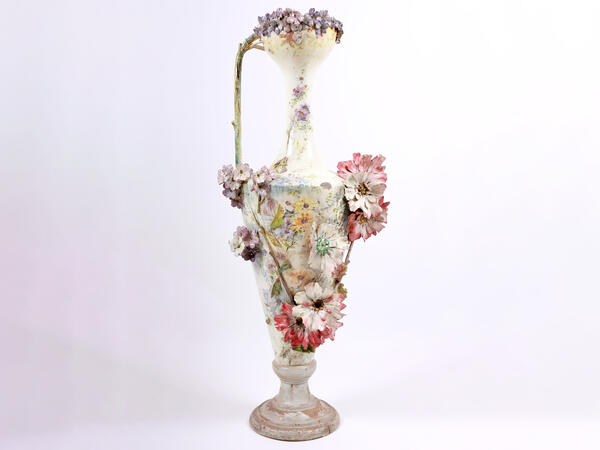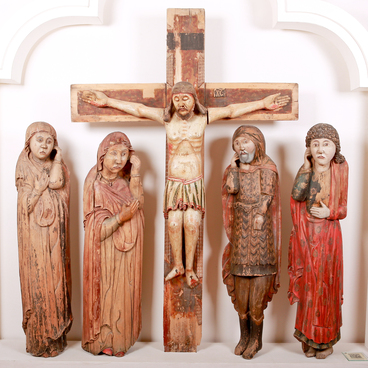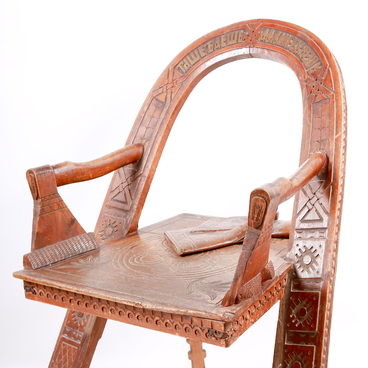The collection of the Kasimov Historical and Cultural Museum-Reserve houses a floor vase decorated with relief flowers. Until the beginning of the 20th century, it belonged to the noble Olenin family and was kept in their estate in the village of Istomino, Kasimov District.
The Olenins purchased the estate from the family of Prince Nikolay Maksutov in the 1860s. They brought collections of porcelain, sculptures, as well as furniture, vases, icons, and paintings to the new house. Some of these items were kept in the Olenin family for centuries and passed down from generation to generation.
The collection of ancient tiles — ceramic tiles used to cover buildings, was of special value. Alexey Olenin bought some of them from workers who demolished old houses in Kasimov.
After the Russian revolution, the Olenins’ estate was nationalized: the land was transferred to the state, and interior items, including furniture, paintings, a collection of porcelain and vases, were sent to the museum. The village of Istomino was transformed into the village of Kasimov Tractor Repair Station (TRS), and later it was named “Krutoyarsky”.
The floor vase from the museum collection was made in the 19th century from white maiolica — baked clay. The neck of the item is decorated with relief lilac flowers, and the body is decorated with blooming chrysanthemums. Additionally, the flowers were covered with translucent paint of purple, pink and yellow shades.
For the first time, vases began to be used in ancient times. Then, they were ordinary household items, and not an interior decoration: the Greeks and Romans used to put jewelry, gold, and silver in them. Wine, water, oil, or grains were stored in high amphorae. Later, when the tradition of decorating ancient temples with flowers appeared, people would put bouquets in vases. In ancient times, such vessels were handmade by the craftsmen, so they were inaccessible to ordinary people — only pharaohs, emperors and kings could afford them.
In the age of Renaissance, in the 17th century, not only the practical application of vases but their appearance as well became of great importance. Vases made houses feel cozy; they were placed on the floor or tables. Back then, the craftsmen began to experiment with the size and painting of vases.
In the 18th century, the rococo style, which required special sophistication and a large number of details, became popular. Therefore, in those days, vases had intricate shapes and rich relief decorations. Although the vase from the museum collection was created in the 19th century, its shape and decorations refer to the main features of the Rococo style.
The Olenins purchased the estate from the family of Prince Nikolay Maksutov in the 1860s. They brought collections of porcelain, sculptures, as well as furniture, vases, icons, and paintings to the new house. Some of these items were kept in the Olenin family for centuries and passed down from generation to generation.
The collection of ancient tiles — ceramic tiles used to cover buildings, was of special value. Alexey Olenin bought some of them from workers who demolished old houses in Kasimov.
After the Russian revolution, the Olenins’ estate was nationalized: the land was transferred to the state, and interior items, including furniture, paintings, a collection of porcelain and vases, were sent to the museum. The village of Istomino was transformed into the village of Kasimov Tractor Repair Station (TRS), and later it was named “Krutoyarsky”.
The floor vase from the museum collection was made in the 19th century from white maiolica — baked clay. The neck of the item is decorated with relief lilac flowers, and the body is decorated with blooming chrysanthemums. Additionally, the flowers were covered with translucent paint of purple, pink and yellow shades.
For the first time, vases began to be used in ancient times. Then, they were ordinary household items, and not an interior decoration: the Greeks and Romans used to put jewelry, gold, and silver in them. Wine, water, oil, or grains were stored in high amphorae. Later, when the tradition of decorating ancient temples with flowers appeared, people would put bouquets in vases. In ancient times, such vessels were handmade by the craftsmen, so they were inaccessible to ordinary people — only pharaohs, emperors and kings could afford them.
In the age of Renaissance, in the 17th century, not only the practical application of vases but their appearance as well became of great importance. Vases made houses feel cozy; they were placed on the floor or tables. Back then, the craftsmen began to experiment with the size and painting of vases.
In the 18th century, the rococo style, which required special sophistication and a large number of details, became popular. Therefore, in those days, vases had intricate shapes and rich relief decorations. Although the vase from the museum collection was created in the 19th century, its shape and decorations refer to the main features of the Rococo style.


